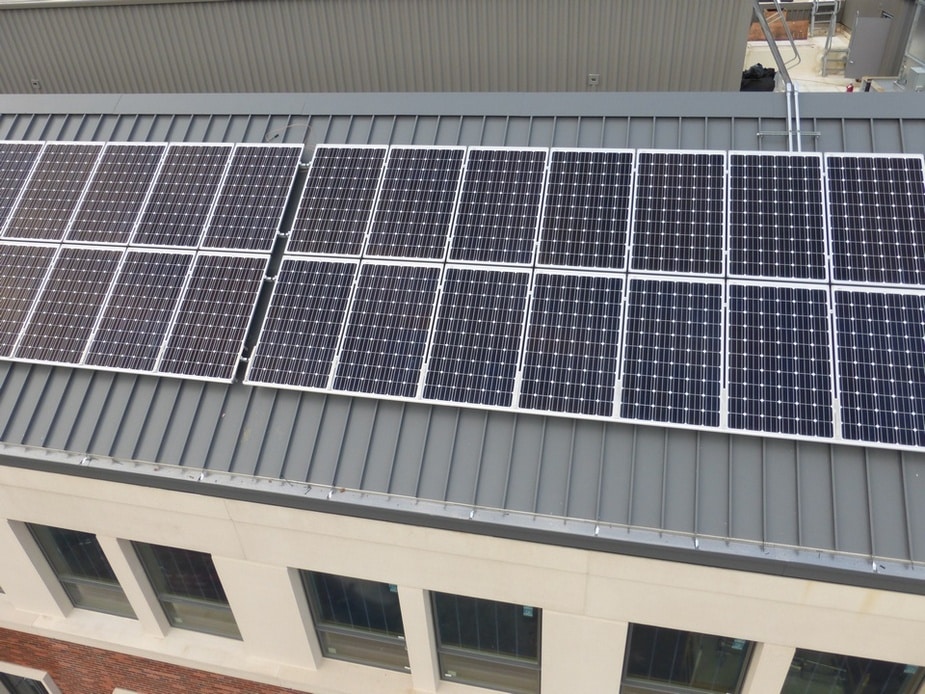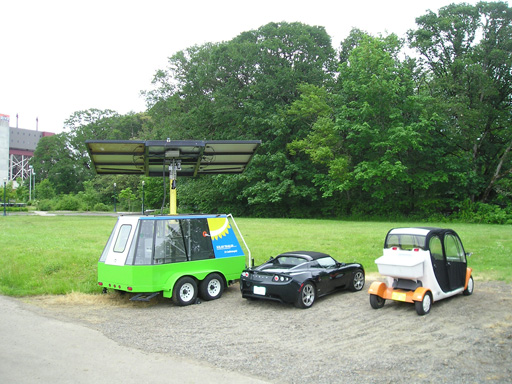Beth Ray Center
Coming soon!
Western Shops Building
The Western Shops building enhances the campus experience for students, staff, and visitors by providing exemplary maintenance programs that support systems, structures, and grounds to foster university success. Completed in 2021, Western Shops includes a 358-kilowatt photovoltaic roof-mounted solar system, currently the largest roof mounted solar array in Corvallis!

Student Experience Center
Completed in 2015, the Student Experience Center includes a 48-kilowatt photovoltaic roof-mounted solar system.

A 2.4 kilowatt photovoltaic system was installed on the Kelley Engineering Center during its construction in 2004. While this relatively small and early vintage system provides a fraction of the power this large commercial building needs, it demonstrates the feasibility and output of solar resources in the Willamette Valley.
A 1.1 kilowatt array at HMSC in Newport demonstrates renewable energy technology to visitors and reflects OSU's commitment to education in sustainable practices. HMSC has also implemented campus-wide energy conservation upgrades including the installation of an energy-efficient lighting and heating/ventilation system that resulted in a 15 percent decrease in electrical consumption.
In 2012 and 2013, five large ground-mounted solar electric (photovoltaic) arrays were installed on agricultural lands operated by Oregon State University as part of “Solar by Degrees,” a large-scale photovoltaic power program coordinated by the organization then known as the Oregon University System. OSU was the first to install its arrays.
The five arrays cover more than twelve acres combined. Three are in Corvallis and two are at OSU properties in Aurora and Hermiston. The 35th Street site is the largest, at around six acres and 1,435 kilowatts. It can be found west of the Corvallis campus on the Campus Way bike path. The 53rd Street array is 289 kilowatts and is located adjacent to the bike path just east of the Benton County Fairgrounds. The Aquatic Animal Heal Lab array, with a capacity of 482 kilowatts, is located adjacent to Trysting Tree golf course just east of the Willamette River, off the main campus. Check real-time monitoring and see more information.
The OSU Solar Trailer is a portable device that captures and stores solar energy. Its purpose is to educate about photovoltaic (solar electric) energy technologies and provide a quiet, renewable, portable power supply.
The Trailer provides electricity to campus and community events such as Beyond Earth Day, the Beaver Community Fair, Oregon Country Fair, and others. Because of its on-board battery system, the Solar Trailer can also power electrical loads at night. Most small loads can be powered indefinitely, while large loads like food trucks have extended power duration during the day. The Trailer can be available for emergency dispatch when remote power requirements exist.
Need visible, renewable, portable energy for your event? Fill out the Solar Trailer request form or find the Trailer on Facebook! Fees are charged to cover labor and a vehicle needed to operate the Solar Trailer. The fee is determined by the location of the event, the number of days required and the number of hours used for set up and tear down of the Trailer. Please see the Fee Book for more detail, or submit a request form indicating you'd like an estimate of fees for your event.
The Solar Trailer was designed by OSU students as a senior project in mechanical engineering and constructed in 2007. The Student Sustainability Initiative provided about $30,000 in project funding in addition to over $20,000 received in product donations and discounts from RJH Enterprises, Outback Power, Smith Glass, MK Battery, Wattsun, Abundant Solar, and Freebird Body and Paint.
In June 2009, the Solar Trailer charged an electric vehicle for the first time. It was a campus visitor's early Tesla Roadster, illustrating that transportation fuels can be renewable too.

In 2013, the Solar Trailer received a major battery technology upgrade, moving from lead acid batteries to lithium ion. The Sustainability Office and Student Sustainability Initiative took the advancements even further by contracting with local company Shift Electric Vehicles to install an onboard Level 2 electric vehicle smart charger. This charger better utilizes the Trailer's improved battery capacity and serves as an innovative way to promote sustainable transportation.
As part of a 2023 Capstone project, four senior-level Mechanical Engineers teamed up to design and implement a new mechanical cable management system for the OSU Solar Trailer. The Solar Trailer has a flexible conduit connecting the panels to the lower part of the trailer, and the new system is designed to prevent the conduit from getting caught or damaging other moving components. The simple device can be easily assembled and adjusted for future uses. Learn more about this project here.
The bike generator is a human-powered device used to generate energy. By pedaling the bike generator, you can power anything from light bulbs to small electronics. How does it work? The generator powers an inverter, which creates the same type of electricity as a household plug. The on-board 12-volt battery provides short-term energy storage so you can take a quick break from pedaling without losing power. The more you plug in, the higher resistance you will feel on the bike!
The bike generator's purpose is to produce renewable electricity for small devices and serve as an outreach resource to inspire energy conservation and efficiency. It has powered lighting, sound systems, small refrigerators & freezers, and cell phone charging stations.
To request the OSU bike generator for your event, please contact us!
Major components include the generator, battery, charge controller, energy display, inverter, and a traditional bicycle. Assembly assistance was provided from Shift Electric Vehicles in Albany, Oregon. Making your own is possible, as most of these parts are sold commercially and there are some pre-assembled versions as well. Total cost for our device was around $1,900.
The 1000-watt inverter converts direct current (DC) from the generator and/or battery to alternating current (AC) for everyday items. Although the bike and battery can only produce constant outputs of up to around 300 watts (depending on the rider), the 1000-watt inverter handles surges from motor-driven devices like refrigerators.
The power produced varies with how fast the rider pedals and how hard they push. This power can then either be used to directly power the inverter or charge the battery. The inverter provides high-quality, constant 120-volt power, making it safe for all standard 120-volt devices.
Switching the battery into the circuit while riding assists the cyclist and allows the bike to power larger loads more consistently and for the rider to take short breaks. With no rider, the battery can power small loads for short times, but is primarily used to smooth the power output. Whenever the demanded wattage is less than what the bike generator is producing, the excess power goes into charging the battery.
Riding the bike at a comfortable pace will produce somewhere around 30-60 watts that can be sustained for as long as the biker can pedal. Increasing the electrical load increases the resistance that the rider encounters and therefore the amount of force that is required to rotate the pedals.
For several years, OSU purchased large amounts of renewable energy certificates (RECs) to offset its electricity use. Following a 2006-2007 campaign led by ASOSU Environmental Affairs, the student population approved a fee of $8.50/student/term during the ASOSU general election, with 70% of voting students voting in favor. This fee supplied funding for REC purchases between 2007 and 2011.
In 2011, OSU purchased enough renewable energy to meet nearly 100% of its electricity needs and was the 5th largest college or university purchaser of renewable energy in the nation. The source of OSU's renewable energy was wind power. All of OSU’s RECs were Green-e certified.
The US Environmental Protection Agency has recognized OSU multiple times for outstanding leadership in renewable energy use. In October 2008, Andrea Norris who, as a student, led the campaign for the renewable energy fee and now works at OSU's Basic Need Center, accepted on OSU's behalf a Green Power Leadership Award in Denver, Colorado. OSU has also been designated the PAC-12 Conference Champion in renewable energy purchases several times and was made a member of the Green Power Leadership Club.
Since 2012, OSU has made much smaller investments in off-site renewable energy – offsetting around 10% of total electricity use each year – instead choosing to focus on development of on-site renewable resources. For a short time after 2013, student fees were dedicated to on-site renewable energy investments rather than RECs, which funded the 48 kW solar installation on the Student Experience Center. Not using student fees, OSU has installed five large ground-mounted solar arrays and continues to add other rooftop solar around campus each year. In 2024 and 2025, there are 7 upcoming solar projects that will add over 2 megawatts of rooftop solar on campus. In total, on-site projects contribute around 5% of OSU’s energy needs. Rather than purchase large volumes of RECs – where there can be a large temporal and spatial disconnect between non-renewable energy use and production of clean energy elsewhere – OSU has since joined the Oregon Community Solar Program, which facilitates purchases from specific, local projects (whereas RECs facilitate purchases from a “pool” of resources). More information on OSU’s involvement in the Oregon Community Solar Program is provided below.
In early 2023, OSU began purchasing renewable energy from off-site solar developments through the Oregon Community Solar Program (OCSP). The OCSP supports solar growth in Oregon while offering a cost savings to electrical purchasers like OSU. In the first set of subscribed meters, OSU is projected to save around $73,500 over 20 years. We expect to subscribe more – and larger – meters later in 2023. Unlike carbon offsets or renewable energy certificates, OCSP subscribers directly purchase production from specific local projects during a 20 year contract period.